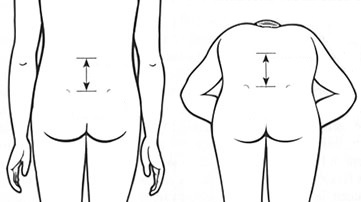Article reviewed and approved by Dr. Ibtissama Boukas, physician specializing in family medicine
Described in 1937 by Dr Paul Schober, a German doctor, the Schober test is a test used in medicine (orthopedics, rheumatology) and rehabilitation to measure the flexion of the Lumbar spine. This article explains the usefulness of this test, its procedure, and the resulting interpretation.
Definition and purpose
Schober's test is used to determine if there is a decrease in the range of motion of the lumbar spine in flexion. It has the advantage of being easily achievable and reproducible.
The measurement of this test is useful for:
- Screening for diseases like ankylosing spondylitis or other inflammatory and congenital diseases.
- To determine the progression and therapeutic effects of modalities aimed at increasing lumbar flexibility and mobility.
Procedure
Here is the procedure for performing the Schober test:
- The patient is standing, the examiner marks the L5 spinous process by drawing a horizontal line across the patient's back (passing through the iliac crests).
- A second line is drawn 10 cm above the first.
- The patient is then asked to lean forward as if he wanted to touch his toes, without bending his knees. The examiner again measures the distance between the two lines with the patient in a fully flexed position.
- The difference between the measurements in the upright position and in the flexed position indicates the result of the Schober test (measurement of the lumbar flexion).
A modified version of Schober's test also exists. This is believed to eliminate misidentification of the lumbosacral junction (L5), and helps ensure that the entire lumbar spine has been considered. To do this, the test is evaluated as follows:
- With the patient standing, the examiner marks the two posterior superior iliac spines (PSIS), then draws a horizontal line down the center of the two marks.
- A second line is marked 5 cm below the first line.
- A third line is drawn 10 cm above the first line.
- The patient is then asked to lean forward as if trying to touch their toes (without bending their knees). Then the examiner again measures the distance between the upper line and the lower line.
Interpretation of the Schober test
For both versions of the test, a increase of less than 5 cm is a positive test, and may indicate reduced lumbar flexion. On the other hand, it should be noted that the Schober test also takes into consideration the amplitude of the hips, and the flexibility of the posterior chain. Thus, reduced hip mobility or stiff hamstrings could affect the Schober test measurement.
References
- https://en.wikipedia.org/wiki/Schober%27s_test
- https://www.physio-pedia.com/Schober_Test
- https://commons.wikimedia.org/wiki/File:Schober_Test.jpg
My name is Anas Boukas and I am a physiotherapist. My mission ? Helping people who are suffering before their pain worsens and becomes chronic. I am also of the opinion that an educated patient greatly increases their chances of recovery. This is why I created Healthforall Group, a network of medical sites, in association with several health professionals.
My journey:
Bachelor's and Master's degrees at the University of Montreal , Physiotherapist for CBI Health,
Physiotherapist for The International Physiotherapy Center


